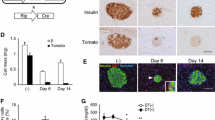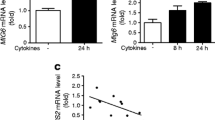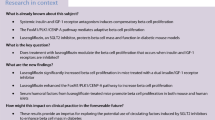Abstract
Glucagon-like peptide 1 (GLP-1) and its analogue exendin-4 (Ex4) have displayed potent glucose homeostasis-modulating characteristics in type 2 diabetes (T2D). However, there are few reports of effectiveness in type 1 diabetes (T1D) therapy, where there is massive loss of β cells. We previously described a novel GLP-1 analogue consisting of the fusion of active GLP-1 and IgG heavy chain constant regions (GLP-1/IgG-Fc), and showed that in vivo expression of the protein, via electroporation-enhanced intramuscular plasmid-based gene transfer, normalized blood glucose levels in T2D-prone db/db mice. In the present study, GLP-1/IgG-Fc and Ex4/IgG-Fc were independently tested in multiple low-dose streptozotocin-induced T1D. Both GLP-1/IgG-Fc and Ex4/IgG-Fc effectively reduced fed blood glucose levels in treated mice and ameliorated diabetes symptoms, where as control IgG-Fc had no effect. Treatment with GLP-1/IgG-Fc or Ex4/IgG-Fc improved glucose tolerance and increased circulating insulin and GLP-1 levels. It also significantly enhanced islet beta-cell mass, which is likely a major factor in the amelioration of diabetes. This suggests that GLP-1/IgG-Fc gene therapy may be applicable to diseases where there is either acute or chronic beta-cell injury.






Similar content being viewed by others
References
Bonner-Weir S . Life and death of the pancreatic beta cells. Trends Endocrinol Metab (2000); 11: 375–378.
Juneja R, Palmer JP . Type 1 1/2 diabetes: myth or reality? Autoimmunity (1999); 29: 65–83.
Goudy KS, Tisch R . Immunotherapy for the prevention and treatment of type 1 diabetes. Int Rev Immunol 2005; 24: 307–326.
Mathis D, Vence L, Benoist C . beta-Cell death during progression to diabetes. Nature 2001; 414: 792–798.
Kahn SE . The importance of the beta-cell in the pathogenesis of type 2 diabetes mellitus. Am J Med 2000; 108 (Suppl 6a): 2S–8S.
Dickson LM, Rhodes CJ . Pancreatic beta-cell growth and survival in the onset of type 2 diabetes: a role for protein kinase B in the Akt? Am J Physiol Endocrinol Metab 2004; 287: E192–E198.
Drucker DJ . Glucagon-like peptides. Diabetes 1998; 47: 159–169.
Wang Q, Brubaker PL . Glucagon-like peptide-1 treatment delays the onset of diabetes in 8 week-old db/db mice. Diabetologia 2002; 45: 1263–1273.
Tourrel C, Bailbe D, Lacorne M, Meile MJ, Kergoat M, Portha B . Persistent improvement of type 2 diabetes in the Goto-Kakizaki rat model by expansion of the beta-cell mass during the prediabetic period with glucagon-like peptide-1 or exendin-4. Diabetes 2002; 51: 1443–1452.
Ogawa N, List JF, Habener JF, Maki T . Cure of overt diabetes in NOD mice by transient treatment with anti-lymphocyte serum and exendin-4. Diabetes 2004; 53: 1700–1705.
Tourrel C, Bailbe D, Meile MJ, Kergoat M, Portha B . Glucagon-like peptide-1 and exendin-4 stimulate beta-cell neogenesis in streptozotocin-treated newborn rats resulting in persistently improved glucose homeostasis at adult age. Diabetes 2001; 50: 1562–1570.
Meier JJ, Nauck MA . Glucagon-like peptide 1(GLP-1) in biology and pathology. Diabetes Metab Res Rev 2005; 21: 91–117.
Holst JJ, Gromada J . Role of incretin hormones in the regulation of insulin secretion in diabetic and nondiabetic humans. Am J Physiol Endocrinol Metab 2004; 287: E199–E206.
Brubaker PL, Drucker DJ . Structure-function of the glucagon receptor family of G protein-coupled receptors: the glucagon, GIP, GLP-1, and GLP-2 receptors. Receptors Channels 2002; 8: 179–188.
Holz GG . New insights concerning the glucose-dependent insulin secretagogue action of glucagon-like peptide-1 in pancreatic beta-cells. Horm Metab Res 2004; 36: 787–794.
Thorens B . Expression cloning of the pancreatic beta cell receptor for the gluco-incretin hormone glucagon-like peptide 1. Proc Natl Acad Sci USA 1992; 89: 8641–8645.
Wang Q, Li L, Xu E, Wong V, Rhodes C, Brubaker PL . Glucagon-like peptide-1 regulates proliferation and apoptosis via activation of protein kinase B in pancreatic INS-1 beta cells. Diabetologia 2004; 47: 478–487.
Wrede CE, Dickson LM, Lingohr MK, Briaud I, Rhodes CJ . Protein kinase B/Akt prevents fatty acid-induced apoptosis in pancreatic beta-cells (INS-1). J Biol Chem 2002; 277: 49676–49684.
Kang G, Joseph JW, Chepurny OG, Monaco M, Wheeler MB, Bos JL et al. Epac-selective cAMP analog 8-pCPT-2′-O-Me-cAMP as a stimulus for Ca2+-induced Ca2+ release and exocytosis in pancreatic beta-cells. J Biol Chem 2003; 278: 8279–8285.
Kashima Y, Miki T, Shibasaki T, Ozaki N, Miyazaki M, Yano H et al. Critical role of cAMP-GEFII--Rim2 complex in incretin-potentiated insulin secretion. J Biol Chem 2001; 276: 46046–46053.
Irwin DM, Irwin DM, Satkunarajah M, Wen Y, Brubaker PL, Pederson RA et al. The Xenopus proglucagon gene encodes novel GLP-1-like peptides with insulinotropic properties. Proc Natl Acad Sci USA 1997; 94: 7915–7920.
Nauck MA . Glucagon-like peptide 1 (GLP-1) in the treatment of diabetes. Horm Metab Res 2004; 36: 852–858.
Gutniak MK, Linde B, Holst JJ, Efendic S . Subcutaneous injection of the incretin hormone glucagon-like peptide 1 abolishes postprandial glycemia in NIDDM. Diabetes Care 1994; 17: 1039–1044.
Nathan DM, Schreiber E, Fogel H, Mojsov S, Habener JF . Insulinotropic action of glucagonlike peptide-I-(7–37) in diabetic and nondiabetic subjects. Diabetes Care 1992; 15: 270–276.
Todd JF, Wilding JP, Edwards CM, Khan FA, Ghatei MA, Bloom SR . Glucagon-like peptide-1 (GLP-1): a trial of treatment in non-insulin-dependent diabetes mellitus. Eur J Clin Invest 1997; 27: 533–536.
Kieffer TJ, McIntosh CH, Pederson RA . Degradation of glucose-dependent insulinotropic polypeptide and truncated glucagon-like peptide 1 in vitro and in vivo by dipeptidyl peptidase IV. Endocrinology 1995; 136: 3585–3596.
Mentlein R, Gallwitz B, Schmidt WE . Dipeptidyl-peptidase IV hydrolyses gastric inhibitory polypeptide, glucagon-like peptide-1(7–36)amide, peptide histidine methionine and is responsible for their degradation in human serum. Eur J Biochem 1993; 214: 829–835.
Ritzel R, Schulte M, Porksen N, Nauck MS, Holst JJ, Juhl C et al. Glucagon-like peptide 1 increases secretory burst mass of pulsatile insulin secretion in patients with type 2 diabetes and impaired glucose tolerance. Diabetes 2001; 50: 776–784.
Toft-Nielsen MB, Madsbad S, Holst JJ . Continuous subcutaneous infusion of glucagon-like peptide 1 lowers plasma glucose and reduces appetite in type 2 diabetic patients. Diabetes Care 1999; 22: 1137–1143.
Ahren B, Schmitz O . GLP-1 receptor agonists and DPP-4 inhibitors in the treatment of type 2 diabetes. Horm Metab Res 2004; 36: 867–876.
Green BD, Gault VA, O'harte FP, Flatt PR . Structurally modified analogues of glucagon-like peptide-1 (GLP-1) and glucose-dependent insulinotropic polypeptide (GIP) as future antidiabetic agents. Curr Pharm Des 2004; 10: 3651–3662.
Chang AM, Chang AM, Jakobsen G, Sturis J, Smith MJ, Bloem CJ et al. The GLP-1 derivative NN2211 restores beta-cell sensitivity to glucose in type 2 diabetic patients after a single dose. Diabetes 2003; 52: 1786–1791.
Kim JG, Baggio LL, Bridon DP, Castaigne JP, Robitaille MF, Jette L et al. Development and characterization of a glucagon-like peptide 1-albumin conjugate: the ability to activate the glucagon-like peptide 1 receptor in vivo. Diabetes 2003; 52: 751–759.
Liu HK, Green BD, Gault VA, McCluskey JT, McClenaghan NH, O'Harte FP et al. N-acetyl-GLP-1: a DPP IV-resistant analogue of glucagon-like peptide-1 (GLP-1) with improved effects on pancreatic beta-cell-associated gene expression. Cell Biol Int 2004; 28: 69–73.
Kumar M, Hunag Y, Glinka Y, Prud'homme GJ, Wang Q . Gene therapy of diabetes using a novel GLP-1/IgG1-Fc fusion construct normalizes glucose levels in db/db mice. Gene Therapy 2006; 122: 162–172.
Drucker DJ . Biological actions and therapeutic potential of the glucagon-like peptides. Gastroenterology 2002; 122: 531–544.
Siminerio L . Challenges and strategies for moving patients to injectable medications. Diabetes Educ 2006; 32 (Suppl 2): 82S–90S.
Baggio LL, Holland D, Wither J, Drucker DJ . Lymphocytic infiltration and immune activation in metallothionein promoter-Exendin-4 (MT-Exendin) transgenic mice. Diabetes 2006; 55: 1562–1570.
Reimold AM . TNFalpha as therapeutic target: new drugs, more applications. Curr Drug Targets Inflamm Allergy 2002; 1: 377–392.
Weir AN, Nesbitt A, Chapman AP, Popplewell AG, Antoniw P, Lawson AD . Formatting antibody fragments to mediate specific therapeutic functions. Biochem Soc Trans 2002; 30: 512–516.
Dupuis DS, Perez M, Halazy S, Colpaert FC, Pauwels PJ . Magnitude of 5-HT1B and 5-HT1A receptor activation in guinea-pig and rat brain: evidence from sumatriptan dimer-mediated [35S]GTPgammaS binding responses. Brain Res Mol Brain Res 1999; 67: 107–123.
George SR, O'Dowd BF, Lee SP . G-protein-coupled receptor oligomerization and its potential for drug discovery. Nat Rev Drug Discov 2002; 1: 808–820.
Larrick JW, Fry KE . Recombinant antibodies. Hum Antibodies Hybridomas 1991; 2: 172–189.
Fountoulakis M, Mesa C, Schmid G, Gentz R, Manneberg M, Zulauf M et al. Interferon gamma receptor extracellular domain expressed as IgG fusion protein in Chinese hamster ovary cells. Purification, biochemical characterization, and stoichiometry of binding. J Biol Chem 1995; 270: 3958–3964.
King LB, Monroe JG . Immunobiology of the immature B cell: plasticity in the B-cell antigen receptor-induced response fine tunes negative selection. Immunol Rev 2000; 176: 86–104.
Prud'homme GJ . Altering immune tolerance therapeutically: the power of negative thinking. J Leukoc Biol 2004; 75: 586–599.
Sun N, Yang G, Zhao H, Savelkoul HF, An L . Multidose streptozotocin induction of diabetes in BALB/c mice induces a dominant oxidative macrophage and a conversion of TH1 to TH2 phenotypes during disease progression. Mediators Inflamm 2005; 2005: 202–209.
Lukic ML, Stosic-Grujicic S, Shahin A . Effector mechanisms in low-dose streptozotocin-induced diabetes. Dev Immunol 1998; 6: 119–128.
Muller A, Schott-Ohly P, Dohle C, Gleichmann H . Differential regulation of Th1-type and Th2-type cytokine profiles in pancreatic islets of C57BL/6 and BALB/c mice by multiple low doses of streptozotocin. Immunobiology 2002; 205: 35–50.
Herold KC, Vezys V, Sun Q, Viktora D, Seung E, Reiner S et al. Regulation of cytokine production during development of autoimmune diabetes induced with multiple low doses of streptozotocin. J Immunol 1996; 156: 3521–3527.
Prud'homme GJ, Chang Y . Prevention of autoimmune diabetes by intramuscular gene therapy with a nonviral vector encoding an interferon-gamma receptor/IgG1 fusion protein. Gene Therapy 1999; 6: 771–777.
Anderson MS, Bluestone JA . The NOD mouse: a model of immune dysregulation. Annu Rev Immunol 2005; 23: 447–485.
Keymeulen B, Vandemeulebroucke E, Ziegler AG, Mathieu C, Kaufman L, Hale G et al. Insulin needs after CD3-antibody therapy in new-onset type 1 diabetes. N Engl J Med 2005; 352: 2598–2608.
Hartikka J, Sawdey M, Cornefert-Jensen F, Margalith M, Barnhart K, Nolasco M et al. An improved plasmid DNA expression vector for direct injection into skeletal muscle. Hum Gene Ther 1996; 7: 1205–1217.
Croze F, Prud'homme GJ . Gene therapy of streptozotocin-induced diabetes by intramuscular delivery of modified preproinsulin genes. J Gene Med 2003; 5: 425–437.
Scrogin KE, Hatton DC, Chi Y, Luft FC . Chronic nitric oxide inhibition with L-NAME: effects on autonomic control of the cardiovascular system. Am J Physiol 1998; 274: R367–R374.
Acknowledgements
This work was supported by grants from the Canadian Institute for Health Research (to Q Wang) and the Juvenile Diabetes Research Foundation (PI: Q Wang; Co-PI: G Prud'homme) and the Krembil Foundation (Toronto, Canada; Co-PI: G Prud'homme). Q Wang is a recipient of a Canadian Diabetes Association Scholarship. M Kumar was a recipient of the Canadian Diabetes Association Fellowship. N Soltani was partially supported by an Overseas Scholarship of Hormozgan Medical Science University from Iranian Health Ministry.
Author information
Authors and Affiliations
Corresponding author
Rights and permissions
About this article
Cite this article
Soltani, N., Kumar, M., Glinka, Y. et al. In vivo expression of GLP-1/IgG-Fc fusion protein enhances beta-cell mass and protects against streptozotocin-induced diabetes. Gene Ther 14, 981–988 (2007). https://doi.org/10.1038/sj.gt.3302944
Received:
Revised:
Accepted:
Published:
Issue Date:
DOI: https://doi.org/10.1038/sj.gt.3302944
- Springer Nature Limited
Keywords
This article is cited by
-
Phosphorus ingestion improves oral glucose tolerance of healthy male subjects: a crossover experiment
Nutrition Journal (2015)
-
Neutralizing circulating ghrelin by expressing a growth hormone secretagogue receptor-based protein protects against high-fat diet-induced obesity in mice
Gene Therapy (2015)
-
Efficient Gene Transfer into Neonatal Mouse Brain Using Electroporation
Neurochemical Research (2012)
-
Ectopic expression of glucagon receptor in skeletal muscles improves glucose homeostasis in a mouse model of diabetes
Diabetologia (2012)
-
Lipid Effects of Endocrine Medications
Current Atherosclerosis Reports (2011)




